1993 PONTIAC BONNEVILLE fuel pressure
[x] Cancel search: fuel pressurePage 8 of 322
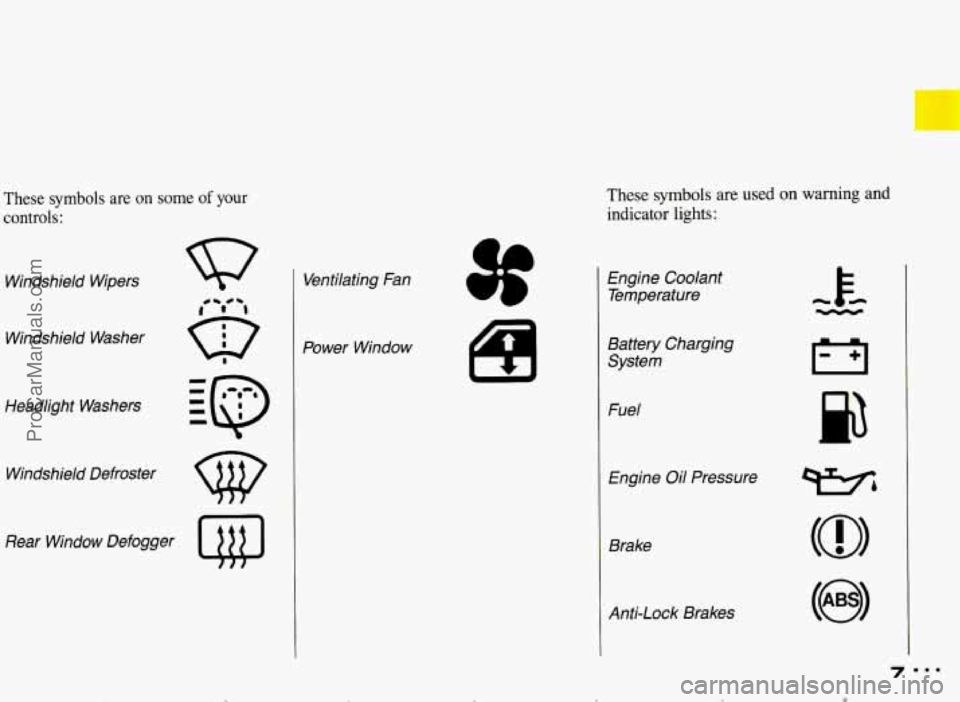
r
These symbols are on some of your
controls:
Windshield Wipers
Windshield Washer
Headlight Washers
Windshield Defroster
Rear Window Defogger
Q@
Ventilating Fan
Power Window
These symbols are used on warning and
indicator lights:
L
I
a
Engine Coolant Temperature
Battery Charging System
Fuel
Engine
Oil Pressure
Brake
Anti-Lock Brakes
ProCarManuals.com
Page 109 of 322
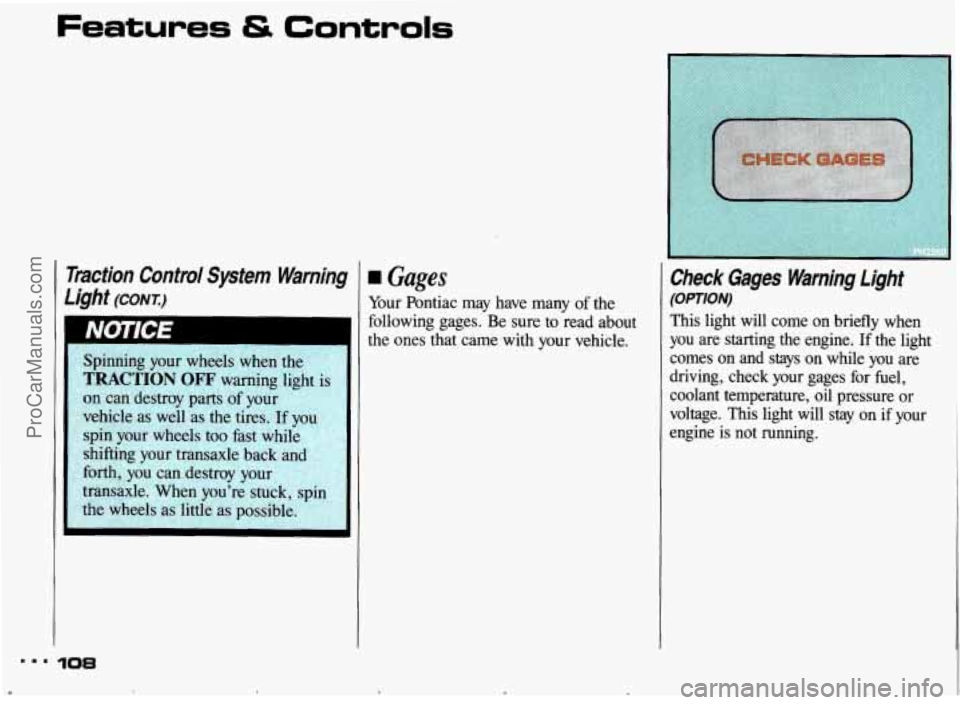
..I
.
Features & Controls
Id
Traction Control System Warning
Light (CONT.)
108
rn Gages
Your Pontiac may have many of the
following gages. Be sure to read about
the ones that came with your vehicle.
Check Gage5 Warning Light
(OPTION)
This light will come on briefly when
you
are starting the engine. If the light
comes
on and stays on while you are
driving, check your gages for fuel,
coolant temperature,
oil pressure or
voltage.
This light will stay on if your
engine
is not running.
ProCarManuals.com
Page 112 of 322
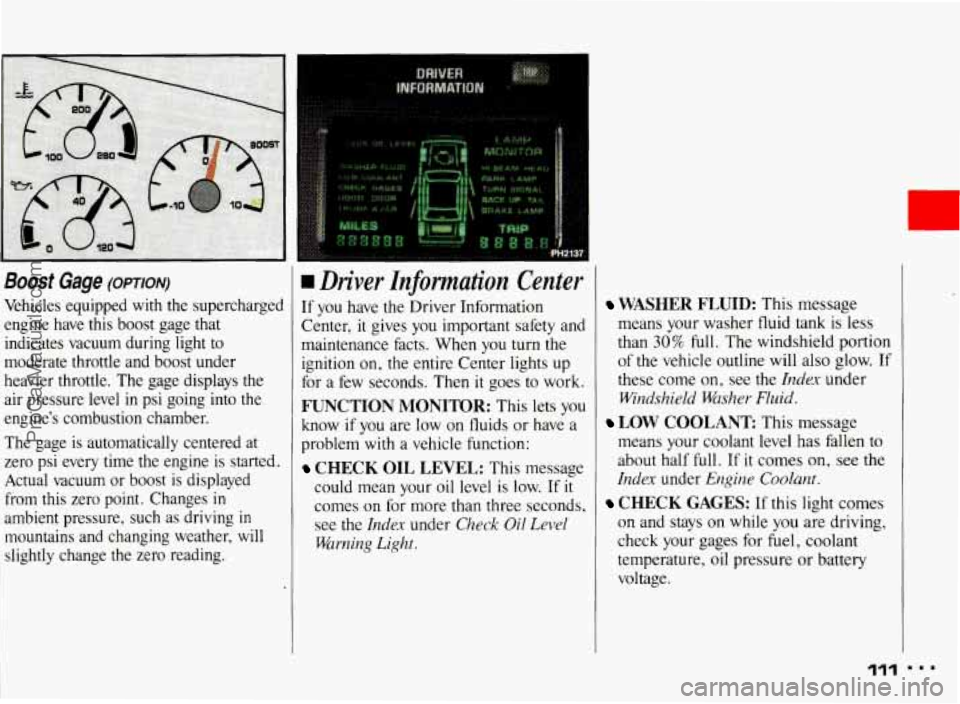
Boost Gage (OPTION)
Vehicles equipped with the supercharged
engine have this boost gage that indicates vacuum during light to
moderate throttle and boost under
heavier throttle. The gage displays the
air pressure level
in psi going into the
engine’s combustion chamber.
The gage is automatically centered at
zero psi
every time the engine is started.
Actual vacuum or boost
is displayed
from this zero point. Changes
in
ambient pressure, such as driving in
mountains and changing weather, will slightly change
the zero reading.
I
rn Driver Znformation Center
If you have the Driver Information
Center, it gives you important safety and
maintenance facts. When you turn the ignition on, the entire Center lights up
for a few seconds. Then it goes to work.
FUNCTION MONITOR: This lets you
know if you are low
on fluids or have a
problem with a vehicle function:
CHECK OIL LEVEL: This message
could mean your oil level is low. If
it
comes on for more than three seconds, see
the Index under Check Oil Level
Warning Light.
WASHER FLUID: This message
means your washer fluid tank is less
than
30% full. The windshield portion
of the vehicle outline will also glow. If
these come on, see the
Index under
Windshield Washer Fluid.
means your coolant level has fallen to
about half full. If it comes on,
see the
Index under Engine Coolant.
CHECK GAGES: If this light comes
on and stays on while
you are driving,
check your gages for fuel, coolant
temperature, oil pressure or battery
voltage.
LOW COOLANT This message
111
ProCarManuals.com
Page 117 of 322
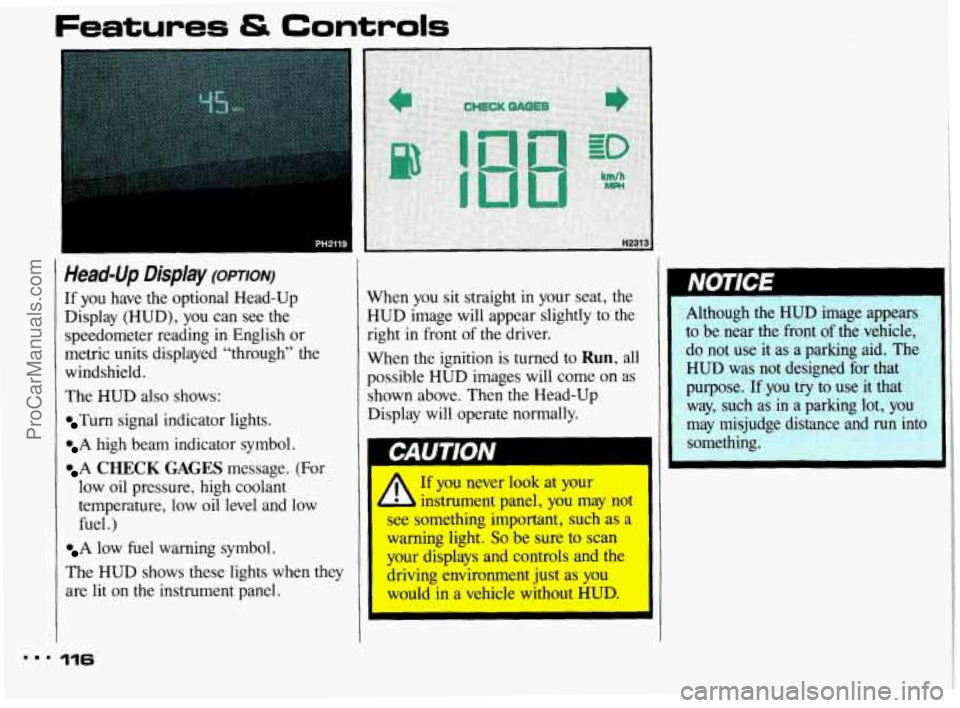
Features & Controls
pH2119
Head-Up Display (omorq
If you have the optional Head-Up
Display (HUD), you can see the
speedometer reading in English or
metric units displayed “through” the
windshield.
The HUD
also shows:
Turn signal indicator lights.
A high beam indicator symbol.
A CHECK GAGES message. (For
low oil pressure, high coolant
temperature, low oil level and low
fuel .)
A low fuel warning symbol.
The HUD shows these lights when they
are lit
on the instrument panel.
... 116
When you sit straight in your seat, the
HUD image will appear slightly to the
right in front
of the driver.
When the ignition is turned
to Run, all
possible HUD images will come on as
shown above. Then the Head-Up
Display will operate normally.
14
NOTEE
Although the HUD image appears
to be near the front
of the vehicle,
do not use it as a parking aid. The
HUD was not designed
for that
purpose.
If you try to use it that
way, such as in a parking lot,
you
may misjudge distance and run into
something.
If you never look at your
b instrument panel, you may not
see something important, such as a
warning light. So be sure to scan
your displays and controls and the
driving environment just
as you
would in a vehicle without
HUD.
ProCarManuals.com
Page 175 of 322
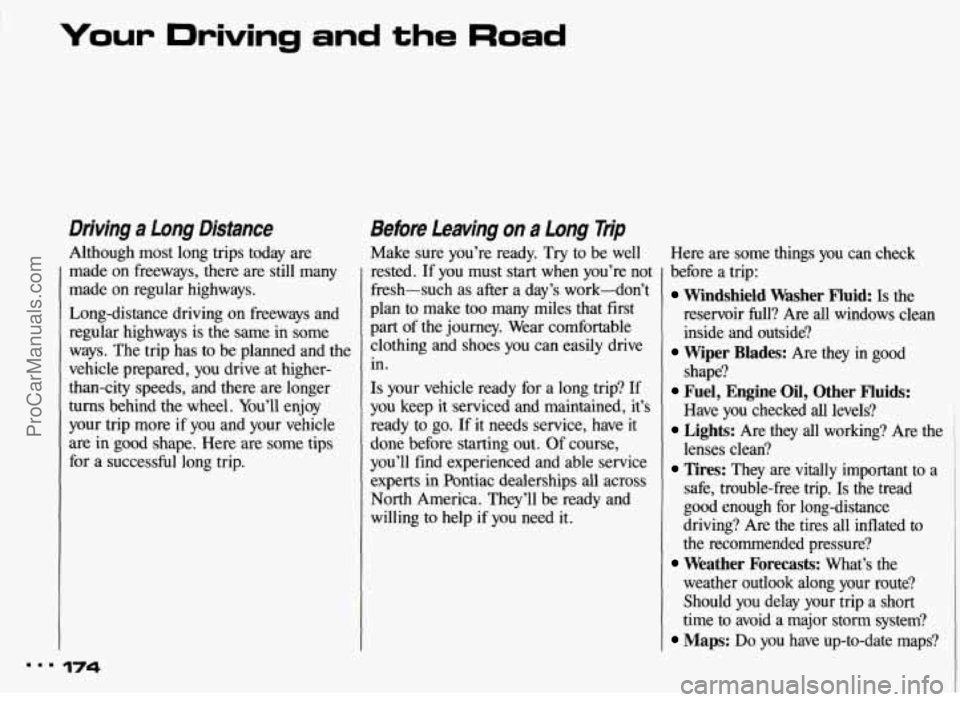
Your Driving and the Road
Driving a Long Distance
Although most long trips today are
made on freeways, there are still many
made on regular highways.
Long-distance driving on freeways and
regular highways
is the same in some
ways. The trip has to be planned and the
vehicle prepared, you drive
at higher-
than-city speeds, and there are longer
turns behind the wheel. You’ll enjoy
your trip more if
you and your vehicle
are in good shape. Here are some tips
for a successful long trip.
174
Before Leaving on a Long Trip
Make sure you’re ready. Try to be well Here are some things you can check
rested. If you must start when you’re not
fresh-such as after a day’s work-don’t
plan to make too many miles that first
part of the journey. Wear comfortable
clothing and shoes you can easily drive
in.
Is your vehicle ready for a long trip? If
you keep it serviced and maintained, it’s
ready to go. If it needs service, have it
done before starting out.
Of course,
you’ll find experienced and able service
experts in Pontiac dealerships all across
North America. They’ll be ready and
willing to help if you need it. before
a trip:
Windshield Washer Fluid: Is the
reservoir full? Are all windows clean
inside and outside?
shape?
Have you checked all levels?
lenses clean?
safe, trouble-free trip.
Is the tread
good enough for long-distance
driving? Are the tires all inflated to
the recommended pressure?
weather outlook along your route?
Should you delay your trip a short
time to avoid a major storm system?
Maps: Do you have up-to-date maps?
Wiper Blades: Are they in good
Fuel, Engine Oil, Other Fluids:
Lights: Are they all working? Are the
Tires: They are vitally important to a
Weather Forecasts: What’s the
ProCarManuals.com
Page 249 of 322
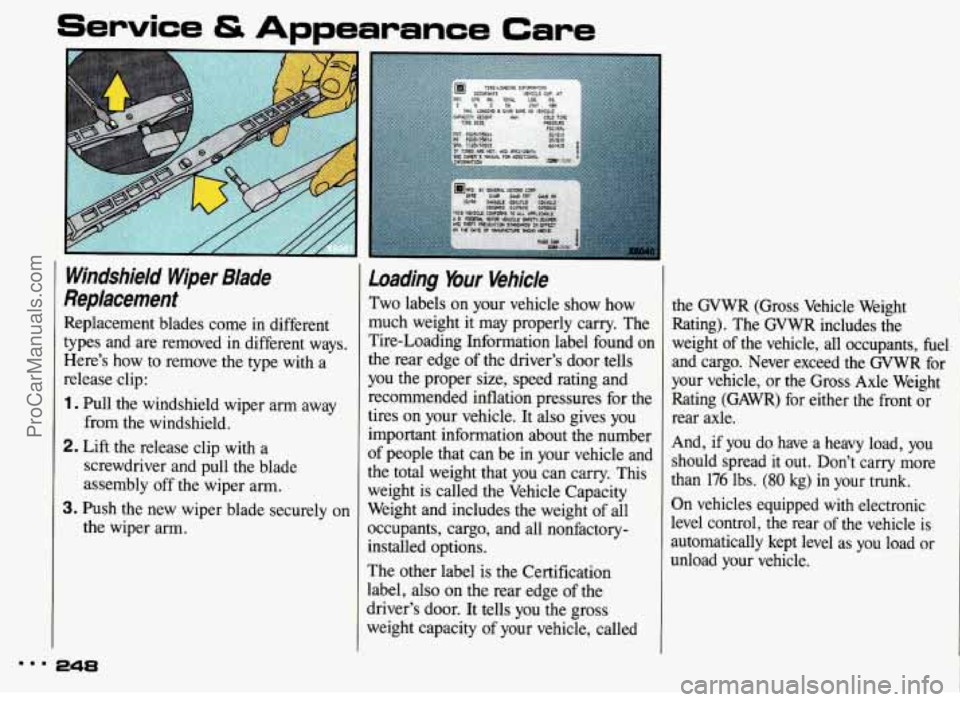
Service & Appearance Care
Windshield Wiper Blade
Replacement
Replacement blades come in different
types and are removed
in different ways.
Here’s how to remove the type with a
release clip:
1. Pull the windshield wiper arm away
2. Lift the release clip with a
from
the windshield.
screwdriver and pull the blade
assembly off the wiper arm.
the wiper arm.
3. Push the new wiper blade securely on
Loading bur Vehicle
Two labels on your vehicle show how
much weight it may properly carry. The
Tire-Loading Information label found on
the rear edge of the driver’s door tells
you the proper size, speed rating and
recommended inflation pressures for the
tires on your vehicle. It also gives you
important information about the number
of people that can be in your vehicle and
the total weight that you can carry. This
weight is called the Vehicle Capacity
Weight and includes the weight of all
occupants, cargo, and all nonfactory-
installed options.
The other label is the Certification
label,
also on the rear edge of the
driver’s door. It tells you the gross
weight capacity of your vehicle, called the
GVWR (Gross Vehicle Weight
Rating). The GVWR includes the
weight of the vehicle, all occupants, fuel
and cargo. Never exceed the GVWR for
your vehicle, or
the Gross Axle Weight
Rating (GAWR) for either the front or
rear axle.
And, if you do have a heavy load,
you
should spread it out. Don’t carry more
than
176 lbs. (80 kg) in your trunk.
On vehicles equipped with electronic
level control, the rear of the vehicle
is
automatically kept level as you load or
unload your vehicle.
... 248
ProCarManuals.com
Page 271 of 322
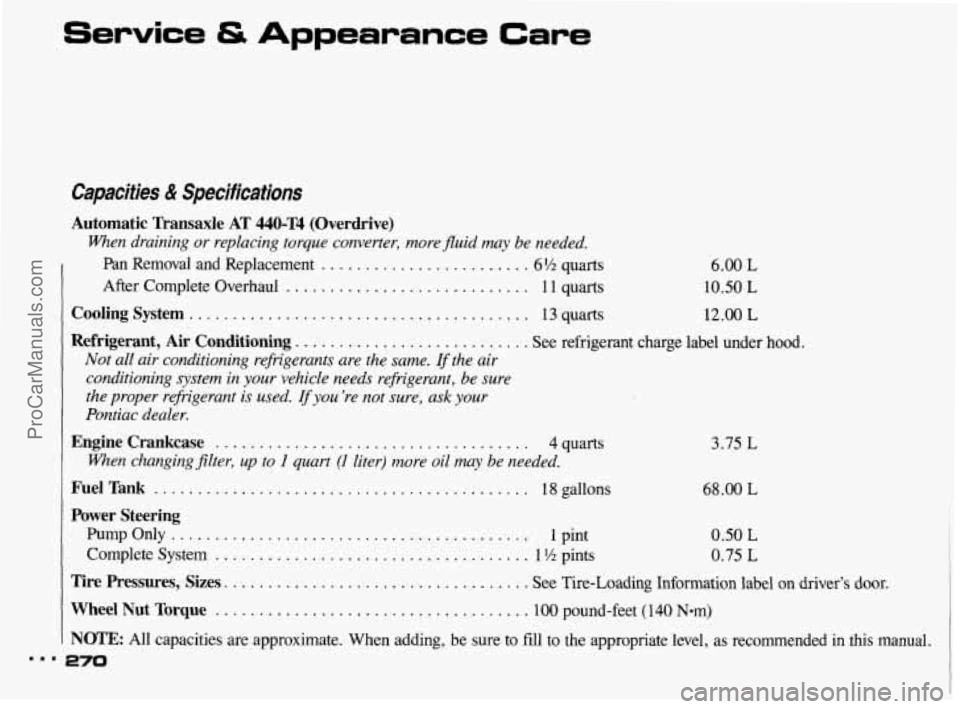
Service & Appearance Care
Capacities & Specifications
Automatic Transaxle AT 440-T4 (Overdrive)
When draining or replacing torque converter, more fluid may be needed.
Pan Removal and Replacement ........................ 6% quarts
After Complete Overhaul
............................ 1 1 quarts
I Cooling System ....................................... 13 quarts
6.00 L
10.50 L
12.00 L
Refrigerant, Air Conditioning ........................... See refrigerant charge label under hood.
Not all air conditioning refrzgerants are the same. If the air
conditioning system in your vehicle needs refiigerant, be sure
the proper refngerant is used.
If you 're not sure, ask your
Pontiac dealer.
Engine Crankcase .................................... 4 quarts
Fuel Tank ........................................... 18 gallons
When changing filter, up to I quart (I liter) more oil may be needed.
3.75 L
68.00 L
Power Steering
Pump Only ......................................... 1 pint 0.50 L
Complete System .................................... 1 !h pints 0.75 L
Tire Pressures, Sizes. .................................. See Tire-Loading Information label on driver's door.
Wheel Nut Torque ..................................... 100 pound-feet (140 Nom)
NOTE: All capacities are approximate. When adding, be sure to fill to the appropriate level, as recommended in this manual.
270 I..
ProCarManuals.com
Page 288 of 322
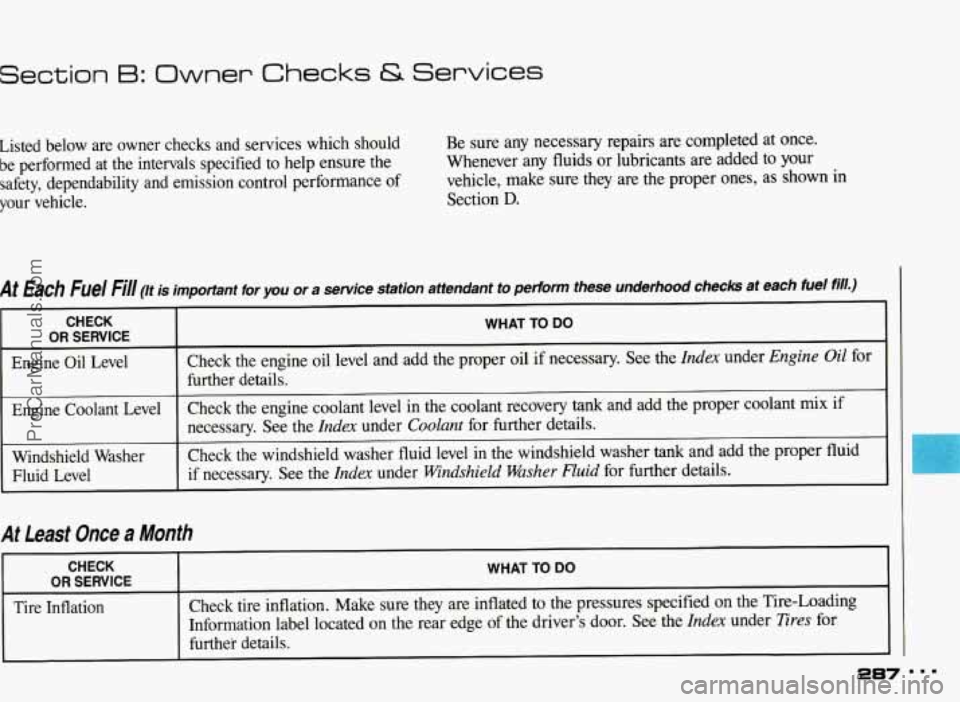
Section B: Owner Checks & Services
Listed below are owner checks and services which should
be performed at the intervals specified to help ensure
the
safety, dependability and emission control performance of
your vehicle. Be
sure any necessary repairs are completed at once.
Whenever any fluids or lubricants are added to your
vehicle, make sure they are the proper ones, as shown in
Section
D.
At Each Fuel Fill (It is important for you or a service station attendant to perform these underhood checks at each fuel fill.)
I I i
CHECK
WHAT TO DO OR SERVICE
Engine Oil Level
Engine Coolant Level Check the engine
oil level and add the proper oil if necessary. See the Index under Engine Oil for
Check
the windshield washer fluid level in the windshield washer tank and add the proper fluid
Windshield Washer Check the
engine coolant level in the coolant recovery
tank and add the proper coolant mix if
Fluid Level
if necessary. See the Index under Windshield Washer Fluid for further details.
further details.
necessary.
See the
Index under Coolant for further details.
At least Once a Month
CHECK
OR SERVICE WHAT TO DO
Tire Inflation
Check tire
inflation. Make sure they are inflated to the pressures specified on the Tire-Loading
Information label located on the rear edge
of the driver’s door. See the Index under Tires for
further details.
287 I
ProCarManuals.com